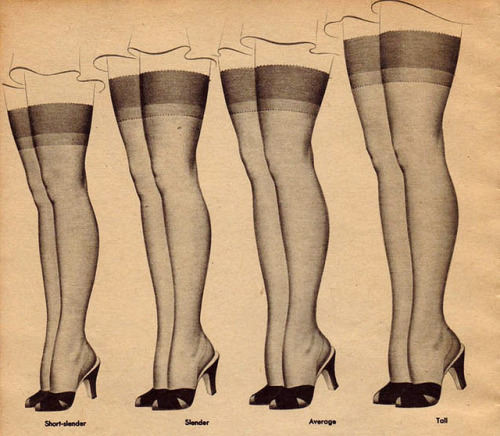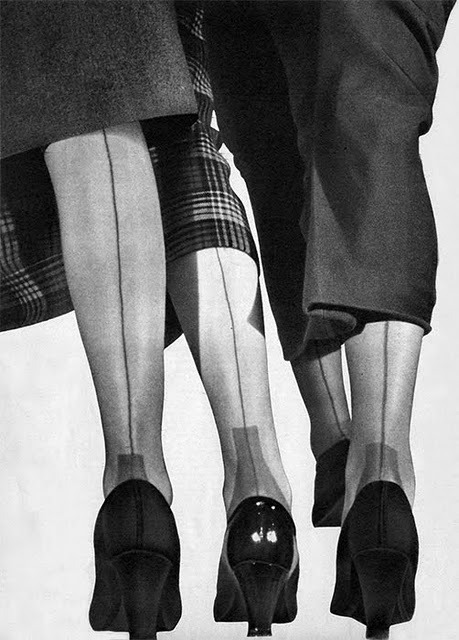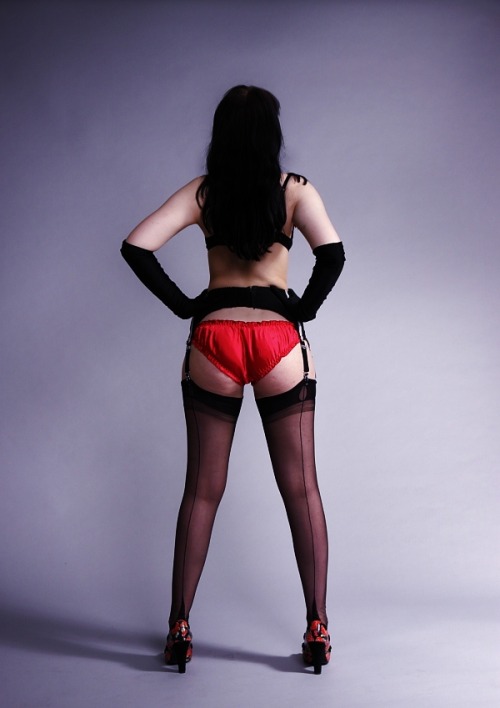 |
| Image source |
This hosiery lesson begins at the heel of post-war nylon mania and runs in a - shall we say, linear - fashion right up to the, er, welt that is the elasticated nylon legwear of today. (I promise, I'm usually a good writer.)
This is particularly aimed at the dear ladies and gents that ever asked me the question, why have you got "lines" running up the back of your "tights"? Perhaps you are wiser now than you were when I was a 16-year-old seamed stocking wearer on the brink of a new world of lingerie discovery because there seams (intentionally cheesy spelling error) to be seamed stockings all over the place now. Even big name, modern hosiery designers like Henry Holland have at least one pair of the classic backseam up for offer. So where did they come from?
 |
| Image Source |
Way back when, these beauties were generally silk which was a real pain in the arse if you weren't super rich. This all changed in the late 30's when Julian Hill, a science guy, was messing around with a heated rod, some coal tar, water and alcohol - as you do - and went "Voila! Nylon!". Nylon stockings were put into production instead as this made them cheaper and far more durable and apparently over 72,000 pairs were sold on the first day (May 15, 1940).
 |
| Me in FFS! Excuse the gratuitous booty shot! |
Today's seamed stockings are knitted in a tube shape with the seam stitched on afterwards - it is an accent rather than a necessity. However, before the birth of tights/pantyhose, stockings were knitted flat with the two sides stitched together in one long seam - the seam held them together. This is the main difference you'll notice between modern and vintage stockings.
Fully fashioneds (of FFs for the purpose of this post) were also knitted with a decrease in stitches towards the ankle, which is why if you hold up a modern stocking it looks like a big blobby tube and if you hold up a pair of FFs you'll see that they are knitted to fit the leg shape. For example:
 |
| See, leg shaped! You know, for your leg? Makes sense really. Image Source |
A final defining factor of the FFS is the welt and keyhole. This is where the stocking has been folded and stitched in a circular motion in order to finish off the seam and withdraw the needle. Yet another example of the major practicalities of a vintage stocking that become less necessary and more aesthetically pleasing.
So here's a run through of the anatomy of a fully fashioned stocking.
 |
| Image Source |
The reason they're so desirable is a) they're bloody gorgeous, b) they're bloody gorgeous and c) they're seriously, really gorgeous. However they are also light as air, less likely to snag, better fitting, more authentic and the seam has far less movement than your modern seamed stocking.
 |
| Stockings by What Katie Did |
Unfortunately, there is reportedly only about 10 of the original stocking machines left. This is understandable considering they're apparently about 50 foot long and only make about 30 pairs at a time (so I've heard, you'll have to verify that one). This means they are hard to find and generally rather expensive. But never fear! Us lingerie bloggers exist to spread the word on these issues and thankfully, due to a massive resurgence in vintage everything, you can still buy them at loads of nifty places.
The most affordable places I've found are:
What Katie Did
Stockings HQ
Kiss Me Deadly
Secrets in Lace
And should you buy them, this is how you put them on! (Video by Secrets in Lace)
Some of my sources for information:
Pandora's Choice
Glamour Daze
Lingerie History
- Booty x
Follow us on








No comments:
Post a Comment